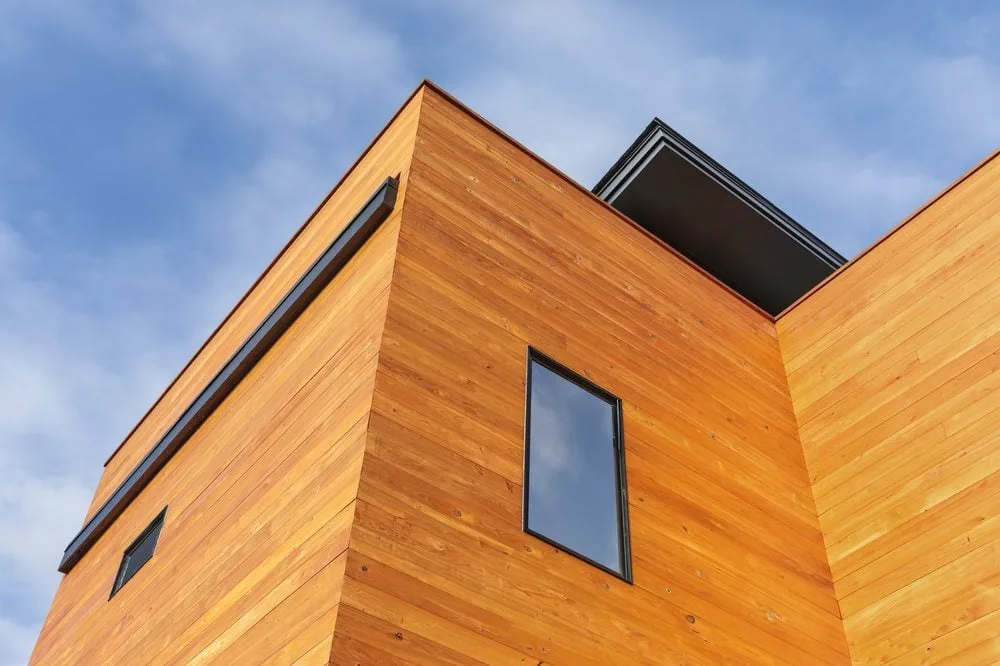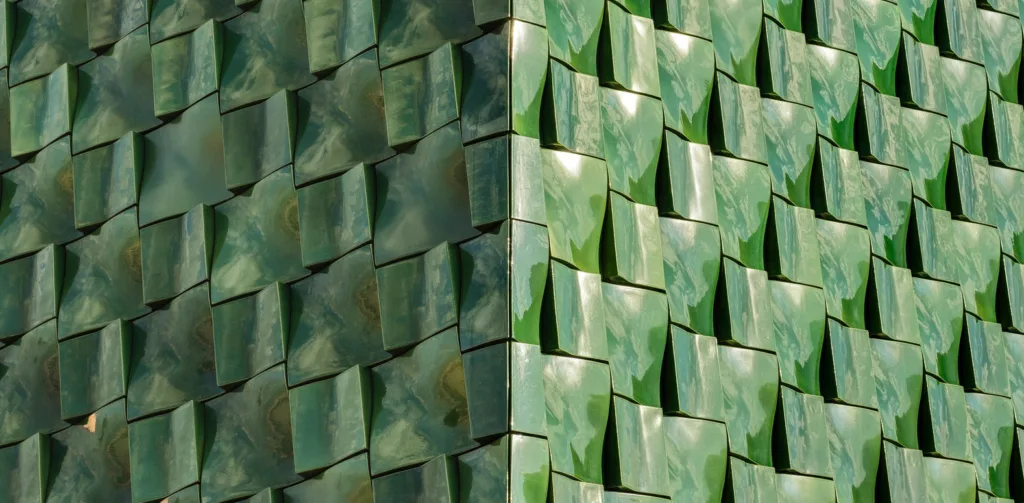The exterior of a building serves as its first impression, and the choice of materials for facades and cladding plays a pivotal role in defining not only its aesthetic appeal but also its durability and environmental impact. From timeless classics like brick and stone to modern innovations in glass and metal, this article delves into the diverse building façade and cladding materials, exploring their unique attributes and the architectural possibilities they offer.
Materials used for building facades and cladding
1. Brick:
Brick, one of the oldest and most enduring building materials, remains a popular choice for building facades due to its classic appearance, durability, and low maintenance. Various types of bricks are used, including:
- Common Bricks: Typically made from clay, these cost-effective bricks are primarily used for structural purposes, often concealed beneath exterior finishes.
- Facing Bricks: These bricks come in various finishes, such as wire-cut, water-struck, and handmade, each offering distinct textures and colours. They are visible on the building’s exterior and can be selected to complement architectural styles.
- Specialty Bricks: This category includes specialised bricks like glazed bricks with a shiny finish, refractory bricks that can withstand high temperatures, and fire bricks used in fire-resistant applications.

2. Stone:
Natural stone, such as granite, marble, and limestone, is renowned for its elegance and durability. Different types of stone used include:
- Natural Stone: This category encompasses various types like granite, known for its strength and a wide range of colours, and marble with its elegant veining. Limestone offers versatility in shades, while sandstone exhibits a natural and textured appearance. Each type can be cut, shaped, and finished to create unique facades.
- Engineered Stone: Materials like terrazzo, engineered quartz, and agglomerates combine crushed stone or aggregates with resins, allowing for customizable colours and patterns. They can be used for both interior and exterior cladding, offering design flexibility.

3. Metal:
Metal cladding materials are prized for their lightweight properties and resistance to corrosion, allowing architects to explore creative designs. Various types of metals used include:
- Aluminum: Lightweight and versatile, aluminum cladding is often chosen for its corrosion resistance. It can be finished with powder coating or anodizing, providing a wide spectrum of colours and textures.
- Steel: Known for its strength, steel is used in structural applications and offers a modern appearance. Different surface treatments, like painting or weathering finishes, can be applied to achieve various aesthetics.
- Copper: Over time, copper develops a unique greenish patina, lending it an evolving, natural appearance suitable for both traditional and contemporary designs.
- Zinc: Zinc cladding offers an elegant and timeless look with a characteristic grayish patina, known for its longevity and low maintenance.

4. Glass:
Glass facades, characterised by transparency and natural light ingress, have transformed modern architecture. Different types of glass used include:
- Curtain Glass: These are structural systems with large glass panels supported by metal frames. They offer expansive views, maximise daylight, and come in various glazing options, such as low-E glass for energy efficiency.
- Glass Panels: Smaller glass units are commonly used for storefronts and building sections where transparency and aesthetics are vital.
- Structural Glazing: Utilising specialised bonding methods, structural glazing eliminates the need for visible framing members, creating a sleek and minimalist look, often employed in modern architecture.

5. Wood:
Wooden cladding, using materials like timber, cedar, and composite wood, imparts a warm and natural aesthetic to building exteriors. Different types of wood used include:
- Timber: Timber cladding comes in various species, each with its unique color and grain pattern. Common choices include oak, pine, and cedar, and sustainable options like bamboo are gaining popularity. Timber can be treated with finishes to enhance durability.
- Cedar: Naturally resistant to decay and insects, cedar is often used for both siding and shingles in residential and commercial buildings.
- Composite Wood: Combines wood fibres with synthetic materials, offering the warmth of wood with improved resistance to decay, insects, and moisture. It can be textured and coloured to resemble natural wood.

6. Concrete:
Concrete is used for cladding and facade applications offering a range of options that combine durability with design versatility. Some common concrete products used include:
- Precast Concrete Panels: Precast concrete panels are factory-made and transported to construction sites for installation. They come in various sizes and can be customized with textures, patterns, and finishes. These panels offer a quick and efficient way to clad building exteriors with the durability and aesthetic qualities of concrete.
- Concrete Tiles: Concrete tiles are a modular and customizable option for cladding and facade design. They come in different shapes, sizes, and finishes, including smooth, textured, or patterned surfaces. Concrete tiles can be arranged creatively to achieve a wide range of visual effects.
- Concrete Blocks: Concrete blocks, often referred to as concrete masonry units (CMUs), serve both structural and cladding purposes. They come in various sizes, colors, and textures, allowing architects to create diverse patterns and visual impacts on building exteriors.
- Architectural Concrete Finishes: Concrete can be finished in various ways to achieve specific textures and appearances, such as exposed aggregate, etching, sandblasting, or brushed finishes. These finishes offer architects and designers a wide range of design possibilities for cladding and facades.

7. Fiber Cement:
Fiber cement materials, valued for their low maintenance, durability, and resistance to fire, moisture, and insects, have become a popular alternative to wood or stucco. These materials offer various textures and finishes suitable for both modern and traditional architectural styles. Different types of fiber cement used include:
- Panels: Fiber cement panels are typically large, flat sheets that offer a sleek, modern appearance. They come in various textures, including smooth and textured finishes.
- Boards: Mimicking the appearance of traditional wooden siding, fiber cement boards can be painted or stained, allowing for a wide range of color choices.
- Shakes: Fiber cement shakes replicate the look of wooden shakes or shingles and are often chosen for their durability and low maintenance.

8. Ceramic:
Ceramic cladding materials are durable and capable of withstanding harsh weather conditions. They can be used to create artistic patterns and mosaics, adding an element of craftsmanship and aesthetics to building exteriors. Different types of ceramic used include:
- Porcelain: Porcelain cladding offers high resistance to staining, fading, and moisture, making it an excellent choice for modern designs with large-format tiles.
- Ceramic Tiles: Ceramic tiles come in various sizes, colors, and glazes, allowing for the creation of intricate patterns and mosaics, adding artistic flair to building exteriors.

9. Composite Materials:
Composite materials, combining different elements to enhance structural strength, insulation properties, and design flexibility, are favoured in contemporary architectural designs. Different composite materials used include:
- – Fiber-Reinforced Polymers (FRP): FRPs combine high-strength fibers, like fiberglass or carbon fiber, with polymer resins. They are lightweight, corrosion-resistant, and suitable for creating innovative facade designs.
- Aluminum Composite Panels (ACP): ACP consists of a polyethylene core sandwiched between two thin aluminum sheets. These panels are known for their versatility, excellent flatness, and wide range of colours and finishes.
- Natural Fiber Composites: These composites incorporate natural fibers like jute or coconut coir within a polymer matrix. They are eco-friendly and can be used for a sustainable, organic look in building exteriors.
- Glass Fiber-Reinforced Concrete (GFRC): GFRC blends glass fibers into a concrete matrix. It’s lighter and more durable than traditional concrete, allowing for intricate and artistic facade elements.
- Wood-Plastic Composite (WPC): WPC combines wood fibers with thermoplastic resins. It offers the warmth and aesthetics of wood with enhanced durability and minimal maintenance.
- Aluminum Foam Panels: These lightweight panels are made by injecting gas bubbles into molten aluminium. They are fire-resistant, excellent insulators, and provide a unique, modern appearance.
- Stone Polymer Composite (SPC): SPC panels incorporate natural stone powder into a polymer matrix. They mimic the look of natural stone while being more lightweight and cost-effective.

10. Plastic:
Plastic cladding materials come in various colours and are known for their insulation properties, making them suitable for energy-efficient designs. Different plastic materials includes;
- Vinyl: Known for its cost-effectiveness and low maintenance, vinyl siding is commonly used in residential buildings. It’s available in various styles, from traditional lap siding to modern panels.
- PVC: PVC cladding offers high durability, resistance to weathering, and ease of maintenance. It’s suitable for various architectural styles and can be used in residential and commercial projects.
- Polycarbonate: Translucent polycarbonate panels are used to create facades with unique lighting effects in modern and artistic designs. They come in various profiles and colors to achieve the desired aesthetics.

11. Terracotta:
Terracotta materials offer diverse design possibilities, adding an element of tradition and elegance to building exteriors. Different types of terracotta used include:
- Terracotta Tiles: Traditional and versatile terracotta tiles allow for various design possibilities.
- Glazed Terracotta: This type of terracotta adds a glossy finish and further protection, enhancing its visual appeal.
- 3D Profiled Terracotta: 3D profiled terracotta offers depth and texture, creating a distinctive and eye-catching façade.

12. Acrylic:
Acrylic materials provide versatility and durability while resisting environmental factors. Different types of acrylic used include:
- Cast Acrylic Sheets: Versatile and available in various thicknesses, cast acrylic sheets are suitable for a wide range of applications.
- Impact-Resistant Acrylic: This type of acrylic provides added durability, making it an excellent choice for areas where impact resistance is essential.
- UV-Protective Acrylic: UV-protective acrylic is designed to resist discoloration from UV exposure, ensuring that the cladding maintains its appearance over time.

Selecting materials for building facades and cladding
Choosing the ideal façade and cladding material is a complex decision that hinges on factors such as the building’s intended purpose, location, budget constraints, local climate conditions, and the desired architectural style. Here is a guide on how to select the right materials for building.
- Define Your Goals: Start by understanding the purpose of the facade and cladding. Is it for insulation, weather protection, aesthetics, or a combination of these? Different materials have varying properties.
- Budget: Determine your budget, as some materials are more expensive than others. Be sure to consider long-term maintenance costs as well.
- Climate and Location: The local climate and environment are crucial. Materials should withstand local weather conditions, be it extreme heat, cold, rain, or humidity.
- Aesthetics: Decide on the desired look and style of the building. Different materials offer various textures, colours, and finishes, which can significantly impact the appearance.
- Durability: Assess the expected lifespan of the materials. Some may require more maintenance and have shorter lifespans, while others are low-maintenance and long-lasting.
- Insulation: Consider the thermal performance of the materials. Some materials offer better insulation, which can impact energy efficiency.
- Maintenance: Think about the maintenance requirements. Some materials need regular cleaning or repainting, while others are more low-maintenance.
- Environmental Impact: Evaluate the sustainability of the materials. Consider their environmental footprint, including resource extraction, manufacturing, and recyclability.
- Local Regulations: Be aware of local building codes and regulations that may dictate which materials are allowed or preferred.
- Consult Professionals: It’s advisable to consult with architects, engineers, and contractors who have experience with facade and cladding materials. They can provide expert guidance based on your specific project.
Conclusion
The choice of materials for façade and cladding is an intricate and multifaceted decision that deeply influences the architectural identity and performance of a structure. From traditional materials like brick and stone to contemporary options such as glass, metal, and sustainable alternatives like wood and composite panels, the selection process must consider a harmonious blend of aesthetics, durability and energy efficiency. Architects and designers must carefully evaluate the specific requirements of each project to determine the most suitable materials for façade and cladding, ensuring the creation of visually


